Rheological and Interaction Analysis of Asphalt Binder, Mastic and Mortar
Abstract
:1. Introduction
2. Materials and Methods
2.1. Materials
2.2. Test Methods
3. Results and Discussion
3.1. Master Curves of Various Asphalt Materials
3.2. Interaction Analysis between Asphalt Binder, Filler and Fine Aggregate
4. Conclusions
- The modulus reinforcement with the addition of filler and fine aggregates into asphalt binder can be well explained by particle reinforcement mechanics. Compared with asphalt binder, asphalt mastic could result in a three- to five-fold increase while asphalt mortar could have a modulus increase of one to two orders of magnitude. The phase change was identified by the significant reduction on phase angle at low frequencies or high temperatures. The combined effect of increasing modulus and reducing phase angle can contribute to high rutting resistance of asphalt mixtures.
- Three interaction parameters were used to analyze the interaction among asphalt binder, filler and fine aggregate. The sensitivity of these parameters was different and did not give a consistent result. The parameters based on phase angle showed large scatter; however, the parameter based on complex modulus was relatively constant.
- The interaction between the asphalt binder and the filler was stronger than its interaction with fine aggregates. Therefore, the specific area could be important for enhancing asphalt binder-filler interaction.
- Asphalt mortar tended to have a constant C value irrespective of type of asphalt binder, fine aggregate and material composition. This allowed for a better prediction of mortar modulus based on asphalt binder modulus. In general, the interaction between asphalt binder, filler and fine aggregate was physical and could be explained by particle filling effect. The temperature sensitivity of mastic and mortar was thus controlled by the type of asphalt binder. The effect of fine aggregate, for example, aggregate contact and friction on rheological properties was prominent at high temperatures. Considering the significant effect of modulus reinforcement and phase change, asphalt mortar could be a vital scale to bridge the gap between asphalt binder and asphalt mixture in a multiscale performance research.
Author Contributions
Funding
Acknowledgments
Conflicts of Interest
References
- Li, Q.; Yang, H.; Ni, F.; Ma, X.; Luo, L. Cause analysis on permanent deformation for asphalt pavements using field cores. Constr. Build. Mater. 2015, 100, 40–51. [Google Scholar] [CrossRef]
- Wu, S.; Zhao, Z.; Xiao, Y.; Yi, M.; Li, M. Evaluation of mechanical properties and aging index of 10-year field aged asphalt materials. Constr. Build. Mater. 2017, 155, 1158–1167. [Google Scholar] [CrossRef]
- Xu, T.; Huang, X. Investigation into causes of in-place rutting in asphalt pavement. Constr. Build. Mater. 2012, 28, 525–530. [Google Scholar] [CrossRef]
- Liu, J.; Zhao, S.; Li, L.; Lic, P.; Saboundjian, S. Low temperature cracking analysis of asphalt binders and mixtures. Cold Reg. Sci. Technol. 2017, 141, 78–85. [Google Scholar] [CrossRef]
- Underwood, B.S.; Kim, Y.R. Microstructural investigation of asphalt concrete for performing multiscale experimental studies. Int. J. Pavement Eng. 2013, 14, 498–516. [Google Scholar] [CrossRef]
- Li, Q.; Chen, X.; Li, G.; Zhang, S. Fatigue resistance investigation of warm-mix recycled asphalt binder, mastic, and fine aggregate matrix. Fatigue Fract. Eng. Mater. 2018, 41, 400–411. [Google Scholar] [CrossRef]
- Füssl, J.; Lackner, R. Multiscale fatigue model for bituminous mixtures. Int. J. Fatigue 2011, 33, 1435–1450. [Google Scholar] [CrossRef]
- Reza Pouranian, M.; Haddock John, E. Determination of voids in the mineral aggregate and aggregate skeleton characteristics of asphalt mixtures using a linear-mixture packing model. Constr. Build. Mater. 2018, 188, 292–304. [Google Scholar] [CrossRef]
- Sreedhar, E.; Coleri, E.; Sadat, S. Selection of a performance test to assess the cracking resistance of asphalt concrete materials. Constr. Build. Mater. 2018, 179, 285–293. [Google Scholar] [CrossRef]
- Gudipudi, P.P.; Underwood, B.S. Use of Fine Aggregate Matrix Experimental Data in Improving Reliability of Fatigue Life Prediction of Asphalt Concrete Sensitivity of This Approach to Variation in Input Parameters. Transp. Res. Rec. 2017, 2631, 65–73. [Google Scholar] [CrossRef]
- Hospodka, M.; Hofko, B.; Blab, R. Introducing a new specimen shape to assess the fatigue performance of asphalt mastic by dynamic shear rheometer testing. Mater. Struct. 2018, 51, 46. [Google Scholar] [CrossRef]
- Mo, L.; Huurman, M.; Wu, S.; Molenaar, A. Ravelling investigation of porous asphalt concrete based on fatigue characteristics of bitumen–stone adhesion and mortar. Mater. Des. 2009, 30, 170–179. [Google Scholar] [CrossRef]
- Lesueur, D.; Blazquez, M.L.; Garcia, D.A.; Rubio, A.R. On the impact of the filler on the complex modulus of asphalt mixtures. Road Mater. Pavement 2018, 19, 1057–1071. [Google Scholar] [CrossRef]
- Liu, G.; Zhao, Y.; Zhou, J.; Li, J.; Yang, T.; Zhang, J. Applicability of evaluation indices for asphalt and filler interaction ability. Constr. Build. Mater. 2017, 148, 599–609. [Google Scholar] [CrossRef]
- Guo, M.; Tan, Y.; Hou, Y.; Wang, L.; Wang, Y. Improvement of evaluation indicator of interfacial interaction between asphalt binder and mineral fillers. Constr. Build. Mater. 2017, 151, 236–245. [Google Scholar] [CrossRef]
- Ziegel, K.D.; Romanov, A. Modulus reinforcement in elastomer composites. I. Inorganic fillers. J. Appl. Polym. 1973, 17, 1119–1131. [Google Scholar]
- Kakade, V.B.; Reddy, M.A.; Reddy, K.S. Rutting performance of hydrated lime modified bituminous mixes. Constr. Build. Mater. 2018, 186, 1–10. [Google Scholar] [CrossRef]
- Huang, B.; Shu, X.; Dong, Q.; Shen, J. Laboratory evaluation of moisture susceptibility of hot-mix asphalt containing cementitious fillers. J. Mater. Civ. Eng. 2010, 22, 667–673. [Google Scholar] [CrossRef]
- Sakanlou, F.; Shirmoha mmadi, H.; Hamedi, G. Investigating the effect of filler types on thermodynamic parameters and their relationship with moisture sensitivity of asphalt mixes. Mater. Struct. 2018, 51, 39. [Google Scholar] [CrossRef]
- Jamshidi, A.; Hasan, M.; Lee, M. Comparative study on engineering properties and energy efficiency of asphalt mixes incorporating fly ash and cement. Constr. Build. Mater. 2018, 168, 295–304. [Google Scholar] [CrossRef]
- Das, A.; Singh, D. Effects of Basalt and Hydrated Lime Fillers on Rheological and Fracture Cracking Behavior of Polymer Modified Asphalt Mastic. J. Mater. Civ. Eng. 2018, 30, 04018011. [Google Scholar] [CrossRef]
- Diab, A.; You, Z. Linear and Nonlinear Rheological Properties of Bituminous Mastics under Large Amplitude Oscillatory Shear Testing. J. Mater. Civ. Eng. 2018, 30, 04017303. [Google Scholar] [CrossRef]
- Zhang, Y.; Leng, Z.; Zou, F.; Wang, L.; Chen, S.; Tsang, D. Synthesis of zeolite a using sewage sludge ash for application in warm mix asphalt. J. Clean. Prod. 2018, 172, 686–695. [Google Scholar] [CrossRef]
- Woszuk, A. Application of fly ash derived zeolites in warm-mix asphalt technology. Materials 2018, 11, 1542. [Google Scholar] [CrossRef] [PubMed]
- Woszuk, A.; Panek, R.; Madej, J.; Zofka, A.; Franus, W. Mesoporous silica material MCM-41: Novel additive for warm mix. Constr. Build. Mater. 2018, 183, 270–274. [Google Scholar] [CrossRef]
- Topal, A.; Sengoz, B.; Kok, B.V.; Yilmaz, M.; Dokandari, P.A.; Oner, J.; Kaya, D. Evaluation of mixture characteristics of warm mix asphalt involving natural and synthetic zeolite additives. Constr. Build. Mater. 2014, 57, 38–44. [Google Scholar] [CrossRef]
- Liu, X.; Liu, W.; Wang, S.; Wang, Z.; Shao, L. Performance Evaluation of Asphalt Mixture with Nanosized Volcanic Ash Filler. J. Transp. Eng. Part B-Pavements 2018, 144, 04018028. [Google Scholar] [CrossRef]
- Wang, W.; Cheng, Y.; Tan, G.; Liu, Z.; Shi, C. Laboratory investigation on high- and low-temperature performances of asphalt mastics modified by waste oil shale ash. J. Mater. Cycles Waste 2018, 20, 1710–1723. [Google Scholar] [CrossRef]
- Sargin, S.; Saltan, M.; Morova, N.; Serin, S.; Terzi, S. Evaluation of rice husk ash as filler in hot mix asphalt concrete. Constr. Build. Mater. 2013, 48, 390–397. [Google Scholar] [CrossRef]
- Zhang, J.; Liu, S.; Yao, Z.; Wu, S.; Jiang, H.; Liang, M.; Qiao, Y. Environmental aspects and pavement properties of red mud waste as the replacement of mineral filler in asphalt mixture. Constr. Build. Mater. 2018, 180, 605–613. [Google Scholar] [CrossRef]
- Choudhary, J.; Kumar, B.; Gupta, A. Application of waste materials as fillers in bituminous mixes. Waste Manag. 2018, 78, 417–425. [Google Scholar] [CrossRef]
- Roman, C.; Garcia-Morales, M. Comparative assessment of the effect of micro- and nano-fillers on the microstructure and linear viscoelasticity of polyethylene-bitumen mastics. Constr. Build. Mater. 2018, 169, 83–92. [Google Scholar] [CrossRef]
- Bocci, E. Use of ladle furnace slag as filler in hot asphalt mixtures. Constr. Build. Mater. 2018, 161, 156–164. [Google Scholar] [CrossRef]
- Giustozzi, F.; Mansour, K.; Patti, F.; Pannirselvam, M.; Fiori, F. Shear rheology and microstructure of mining material-bitumen composites as filler replacement in asphalt mastics. Constr. Build. Mater. 2018, 171, 726–735. [Google Scholar] [CrossRef]
- Al-Khateeb, G.G.; Khedaywi, T.S.; Irfaeya, M.F. Mechanical Behavior of Asphalt Mastics Produced Using Waste Stone Sawdust. Adv. Mater. Sci. Eng. 2018, 5362397. [Google Scholar] [CrossRef]
- Topini, D.; Toraldo, E.; Andena, L.; Mariani, E. Use of recycled fillers in bituminous mixtures for road pavements. Constr. Build. Mater. 2018, 159, 189–197. [Google Scholar] [CrossRef]
- Craus, J.; Ishai, I.; Sides, A. Some physico-chemical aspects of the effect and the role of the filler in bituminous paving mixtures. J. Assoc. Asph. Paving Technol. 1978, 47, 558–588. [Google Scholar]
- Zhou, S.; Liu, S.; Xiang, Y. Effects of Filler Characteristics on the Performance of Asphalt Mastic: A Statistical Analysis of the Laboratory Testing Results. Int. J. Civ. Eng. 2018, 16, 1175–1183. [Google Scholar] [CrossRef]
- Clopotel, C.; Velasquez, R.; Bahia, H. Measuring physico-chemical interaction in mastics using glass transition. Road Mater. Pavement 2012, 13, 304–320. [Google Scholar] [CrossRef]
- Davis, C.; Castorena, C. Implications of physico-chemical interactions in asphalt mastics on asphalt microstructure. Constr. Build. Mater. 2015, 94, 83–89. [Google Scholar] [CrossRef]
- Hesami, E.; Birgisson, B.; Kringos, N. Numerical and experimental evaluation of the influence of the filler-bitumen interface in mastics. Mater. Struct. 2014, 47, 1325–1337. [Google Scholar] [CrossRef]
- Tan, Y.; Li, X.; Wu, J. Internal influence factors of asphalt-aggregate filler interactions based on rheological characteristics. J. Mater. Civ. Eng. 2012, 24, 1520–1528. [Google Scholar]
- Tan, Y.; Guo, M. Interfacial thickness and interaction between asphalt and mineral fillers. Mater. Struct. 2014, 47, 605–614. [Google Scholar] [CrossRef]
- Luo, D.; Guo, M.; Tan, Y. Molecular Simulation of Minerals-Asphalt Interfacial Interaction. Minerals 2018, 8, 176. [Google Scholar] [CrossRef]
- Cheng, Y.; Tao, J.; Jiao, Y.; Tan, G.; Guo, Q.; Wang, S.; Ni, P. Influence of the properties of filler on high and medium temperature performances of asphalt mastic. Constr. Build. Mater. 2016, 118, 268–275. [Google Scholar] [CrossRef]
- Zhang, J.; Fan, Z.; Hu, D.; Hu, Z.; Pei, J.; Kong, W. Evaluation of asphalt–aggregate interaction based on the rheological properties. Int. J. Pavement Eng. 2016, 1–7. [Google Scholar] [CrossRef]
- Liu, G.; Yang, T.; Li, J.; Jia, Y.; Zhao, Y.; Zhang, J. Effects of aging on rheological properties of asphalt materials and asphalt-filler interaction ability. Constr. Build. Mater. 2018, 168, 501–511. [Google Scholar] [CrossRef]
- Kofteci, S.; Nazary, M. Experimental study on usability of various construction wastes as fine aggregate in asphalt mixture. Constr. Build. Mater. 2018, 185, 369–379. [Google Scholar] [CrossRef]
- Rondon-Quintana, H.A.; Ruge-Cardenas, J.C.; Patino-Sanchez, D.F.; Vacca-Gamez, H.A.; Reyes-Lizcano, F.A.; de Farias, M.M. Blast Furnace Slag as a Substitute for the Fine Fraction of Aggregates in an Asphalt Mixture. J. Mater. Civ. Eng. 2018, 30, 04018244. [Google Scholar] [CrossRef]
- Xie, X.; Lu, G.; Liu, P.; Wang, D.; Fan, Q.; Oeser, M. Evaluation of morphological characteristics of fine aggregate in asphalt pavement. Constr. Build. Mater. 2017, 139, 1–8. [Google Scholar] [CrossRef]
- Ma, H.; Zhou, C.; Feng, D.; Sun, L. Influence of Fine Aggregate Content on Low-Temperature Cracking of Asphalt Pavements. J. Mater. Civ. Eng. 2017, 45, 835–842. [Google Scholar] [CrossRef]
- Cong, L.; Wang, T. Effect of fine aggregate angularity on skid-resistance of asphalt pavement using accelerated pavement testing. Constr. Build. Mater. 2018, 168, 41–46. [Google Scholar]
- Xiao, Y.; Wang, F.; Cui, P.; Lei, L.; Lin, J.; Yi, M. Evaluation of Fine Aggregate Morphology by Image Method and Its Effect on Skid Resistance of Micro-Surfacing. Materials 2018, 11, 920. [Google Scholar] [CrossRef] [PubMed]
- Javilla, B.; Mo, L.; Fang, H.; Shu, B.; Wu, S. Multi-stress loading effect on rutting performance of asphalt mixtures based on wheel tracking testing. Constr. Build. Mater. 2017, 148, 1–9. [Google Scholar] [CrossRef]
- JTG F40-2004 Technical Specification for Construction of Highway Asphalt Pavements; People’s Republic of China, Ministry of Transport: Beijing, China, 2004.
- Singh, D.; Ashish, P.K.; Jagadeesh, A. Influence of Particle and Interaction Effects of Different Sizes of Crumb Rubber on Rheological Performance Parameters of Binders. J. Mater. Civ. Eng. 2018, 30, 04018066. [Google Scholar] [CrossRef]

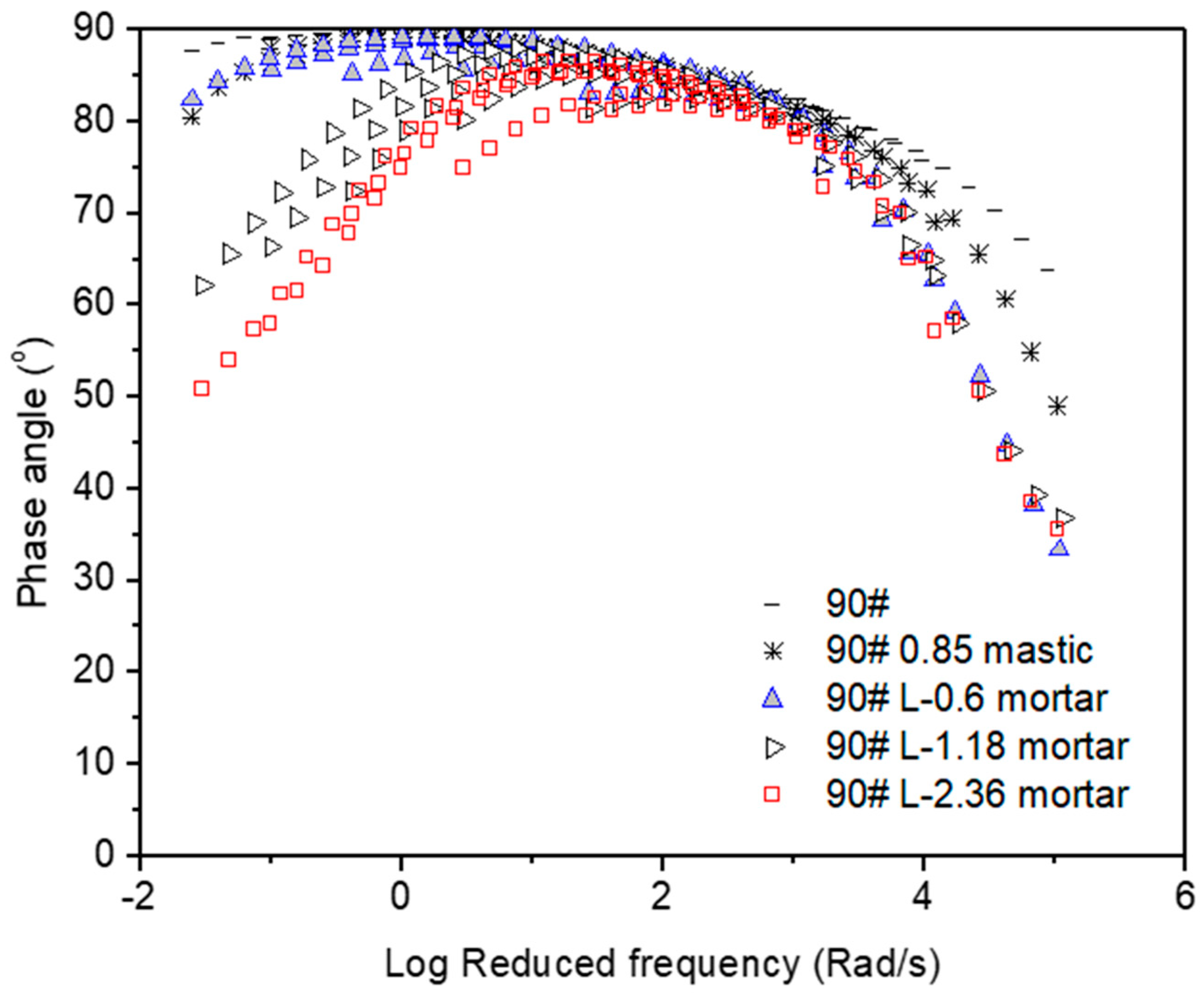
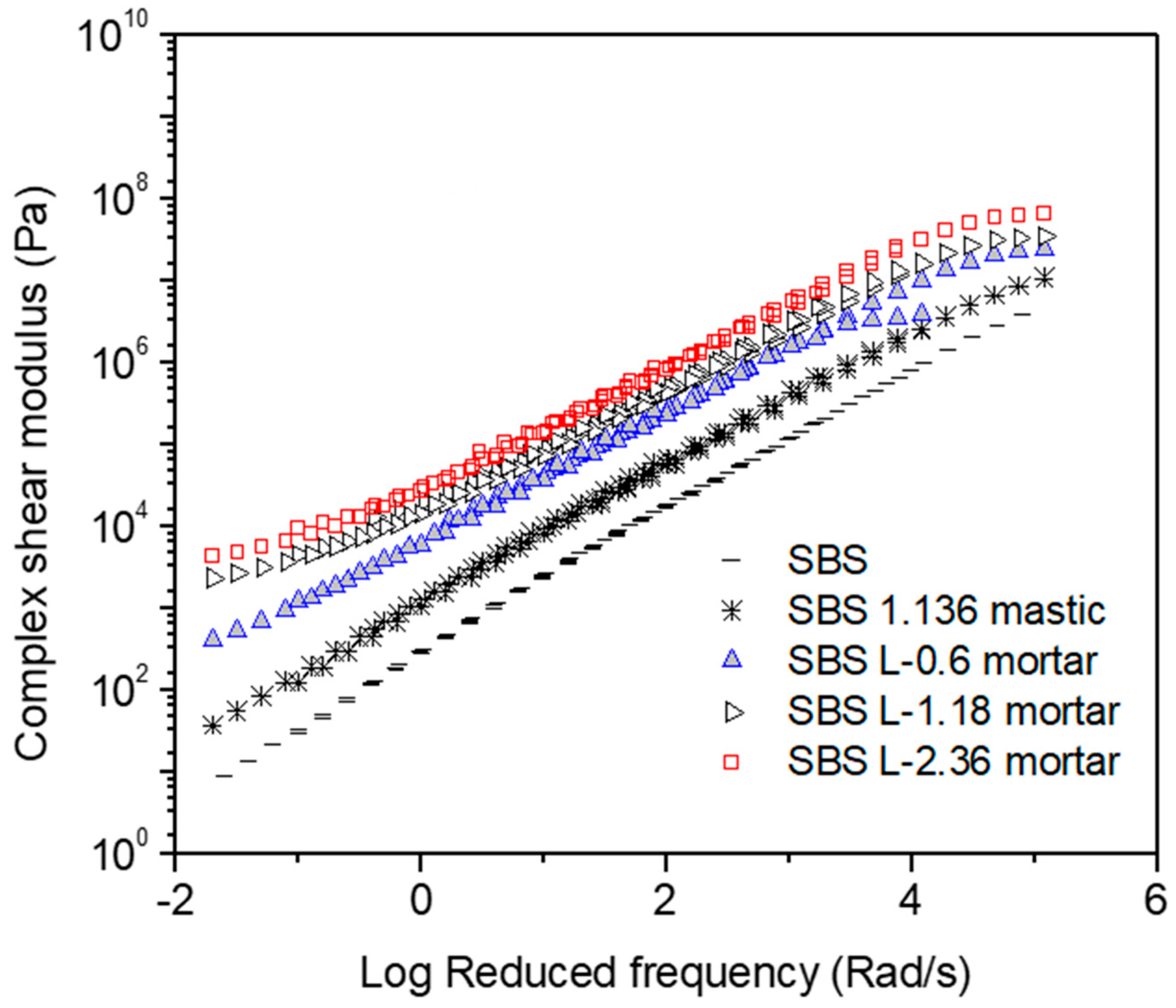
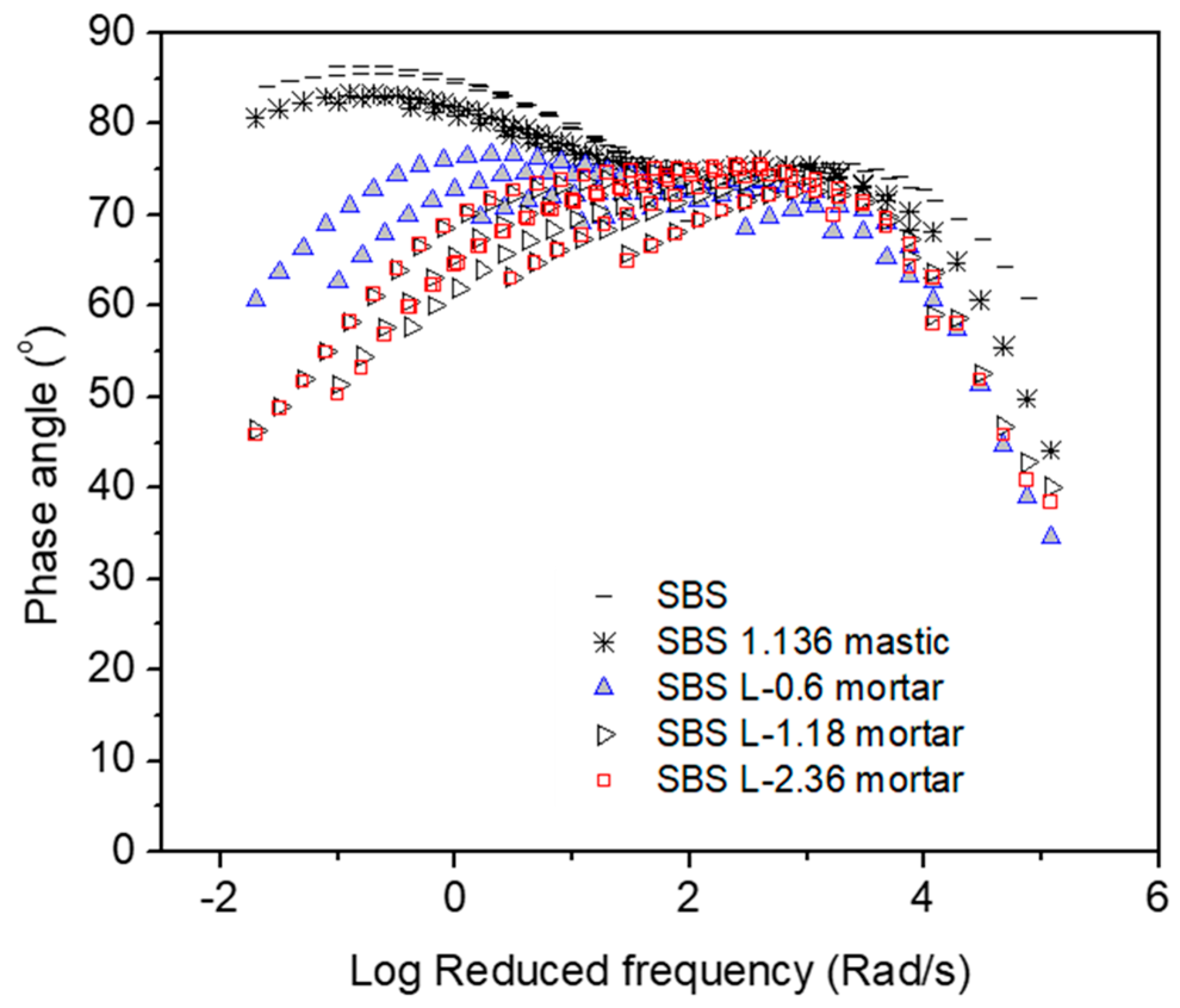
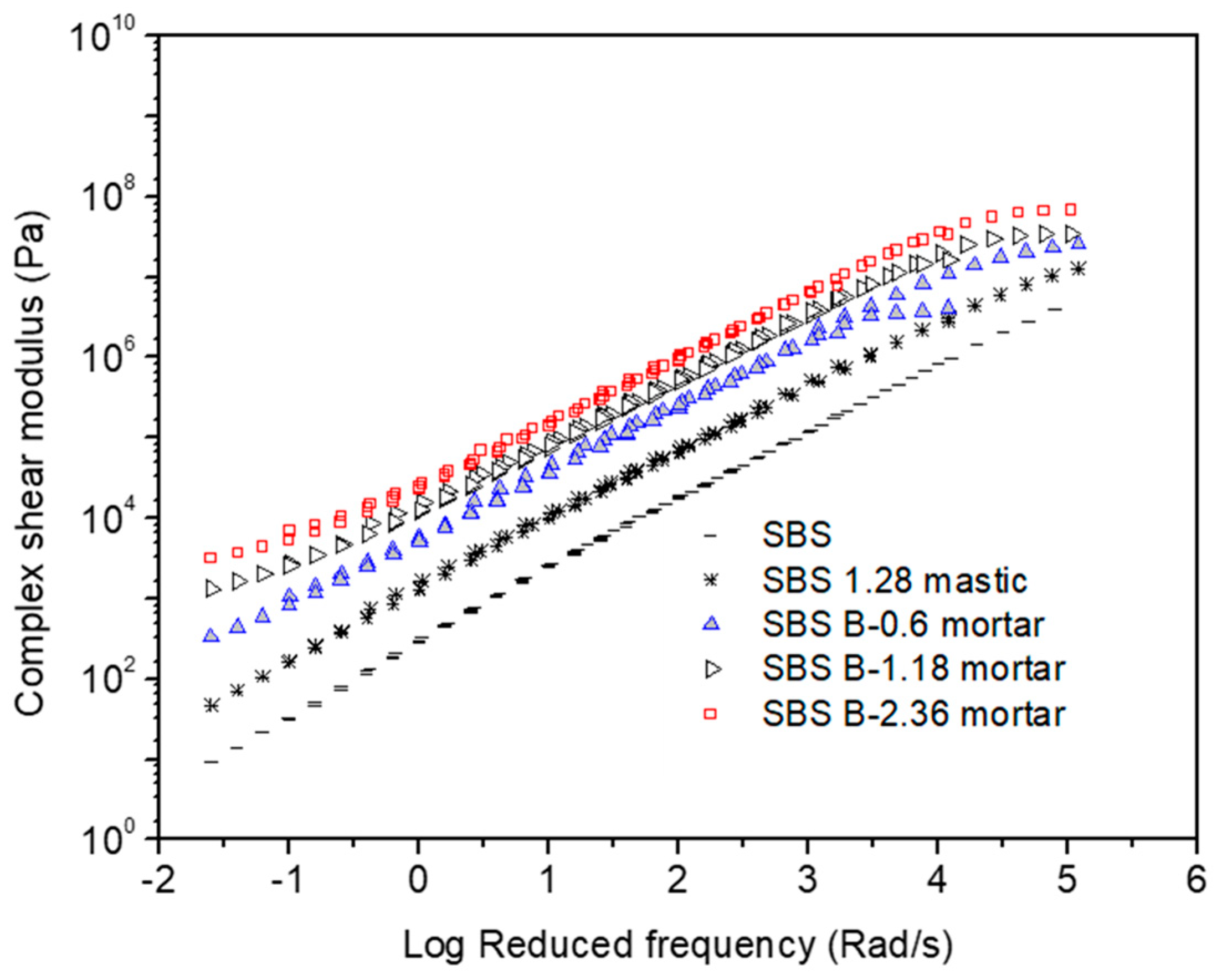
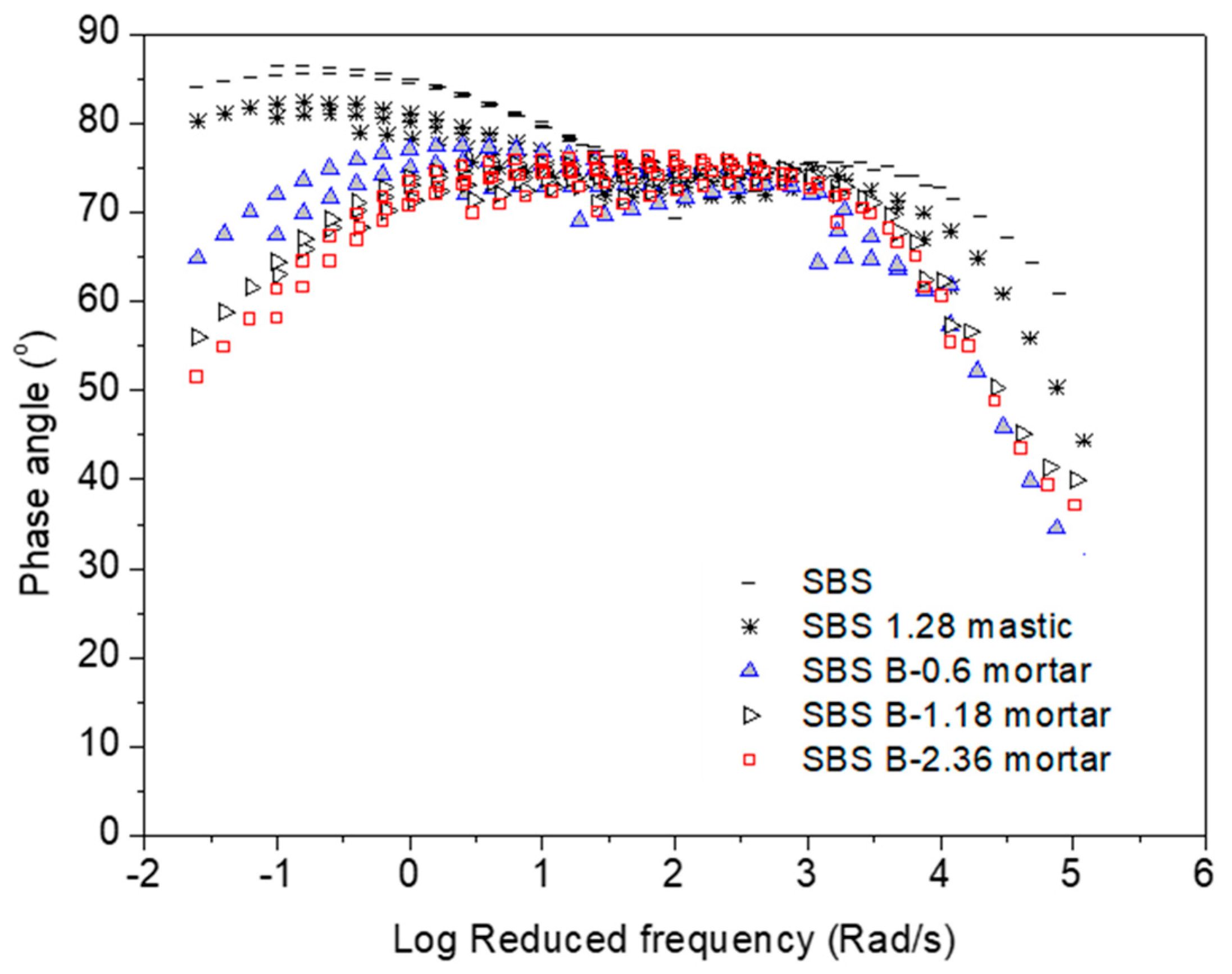
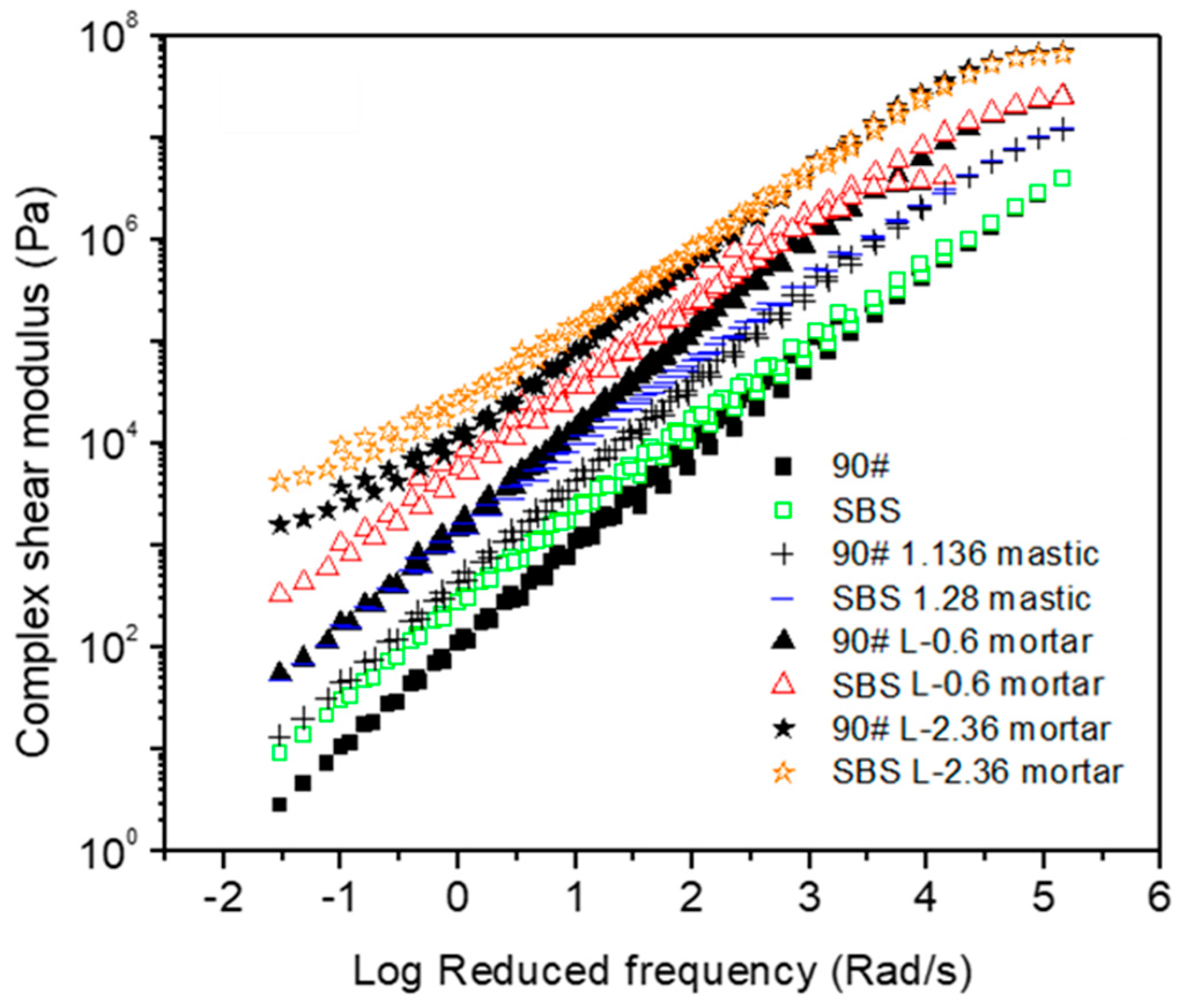
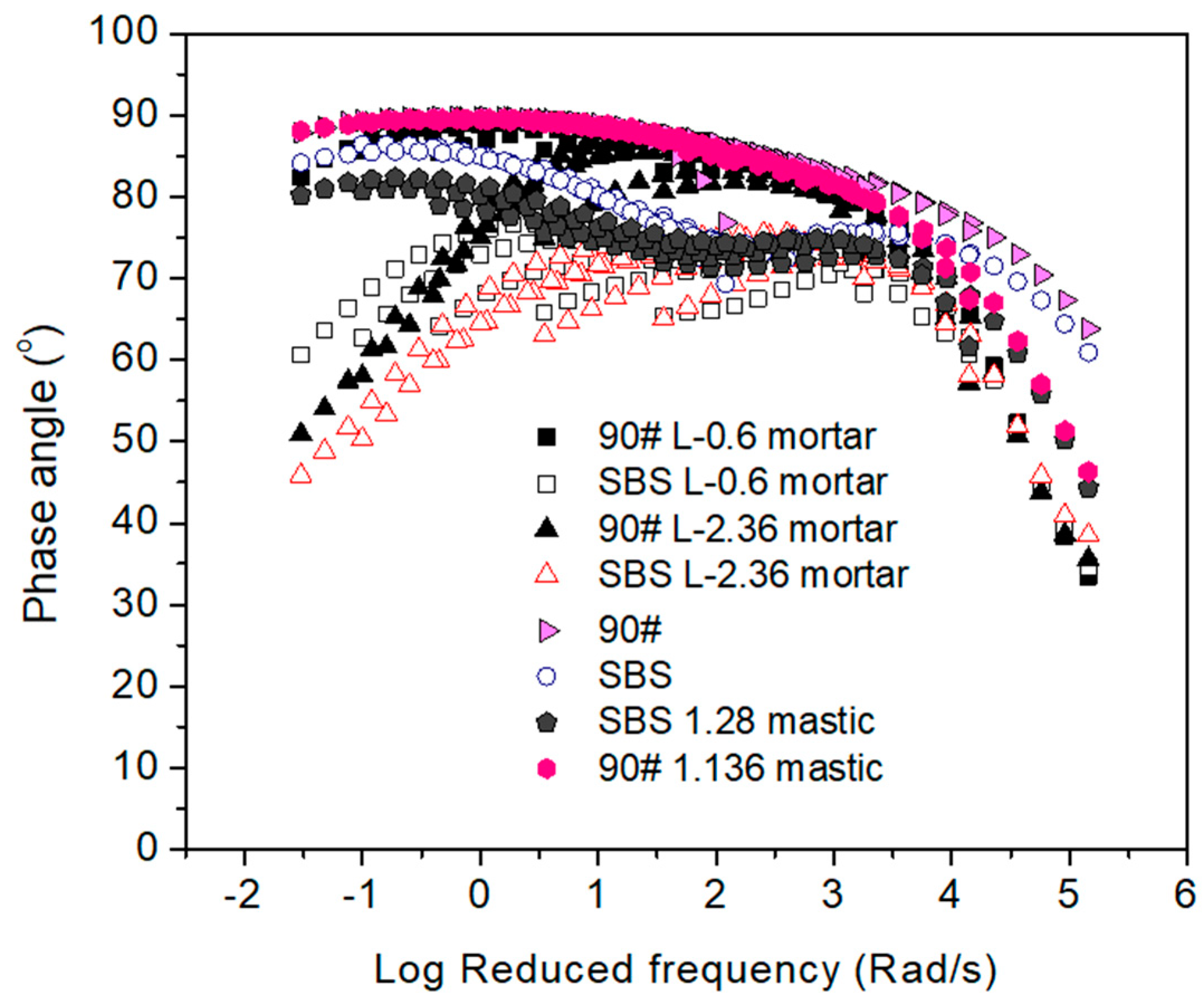
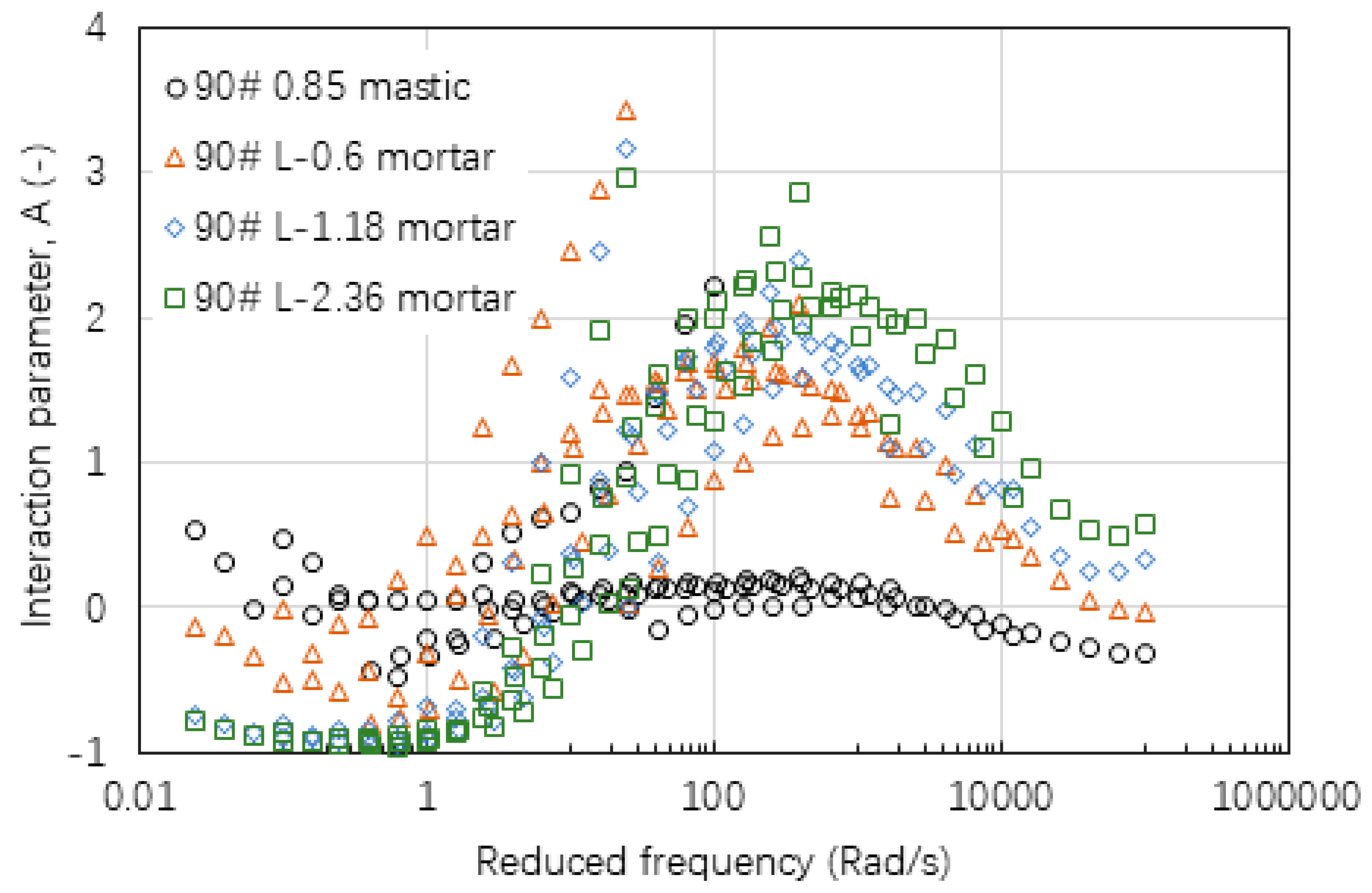
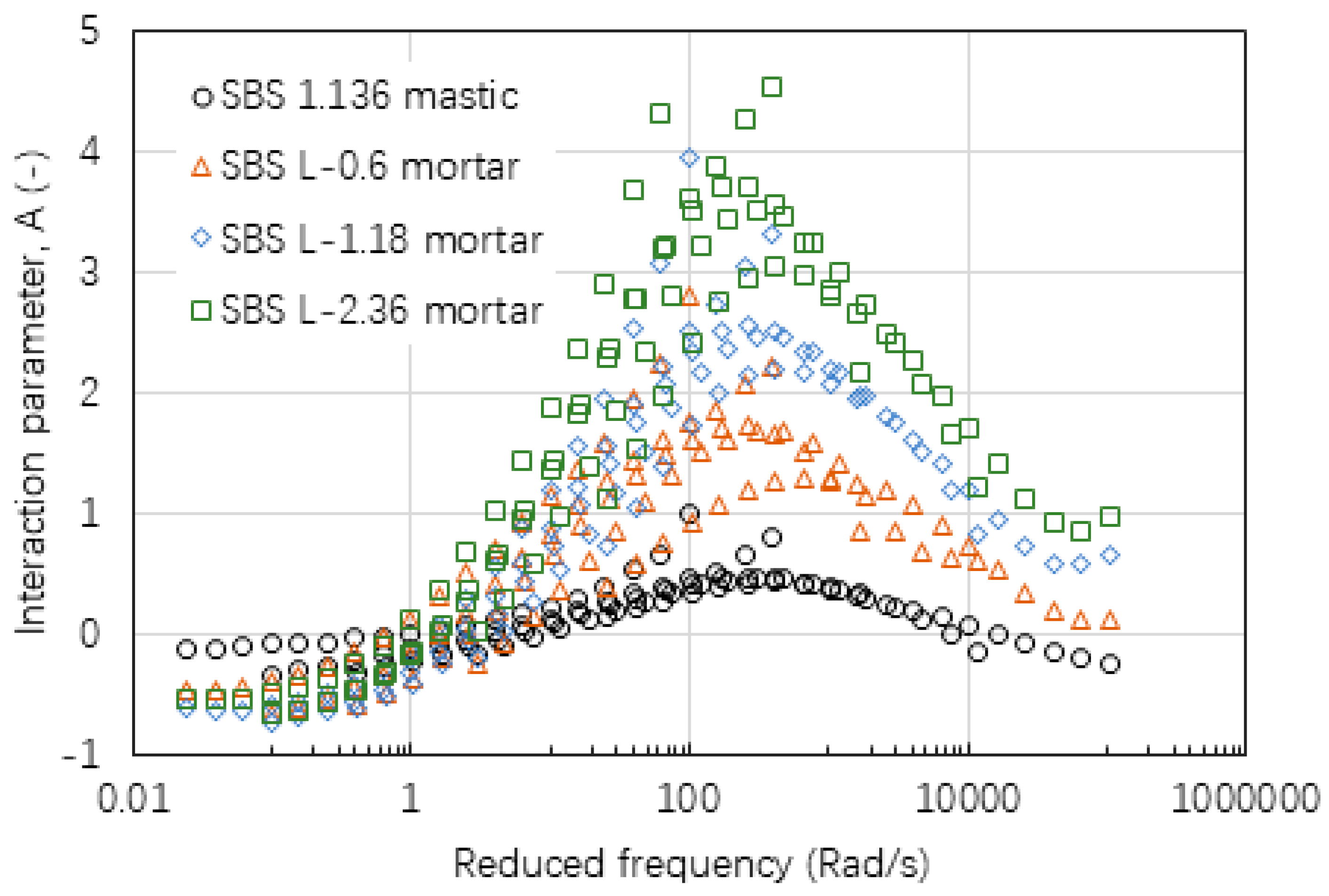
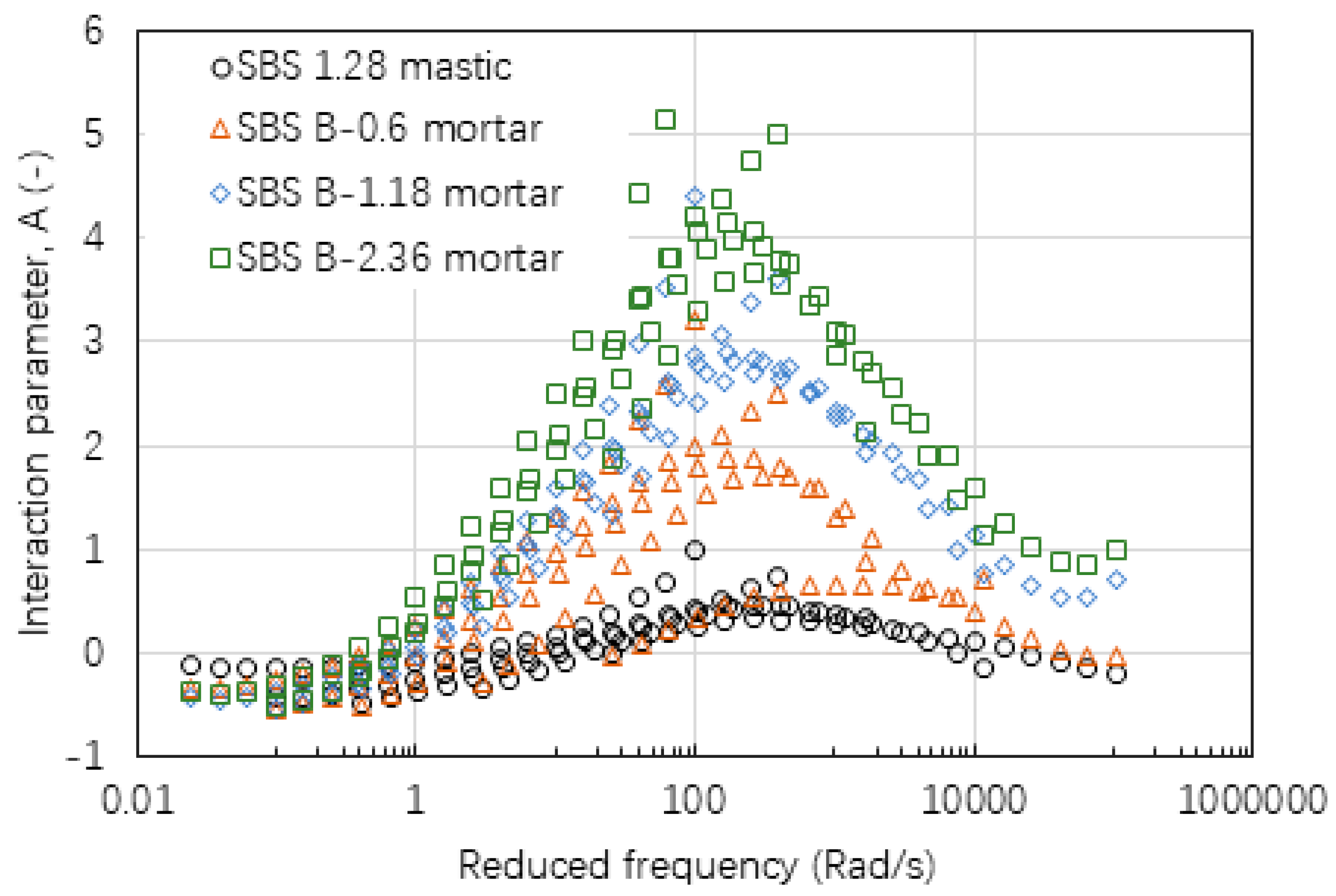
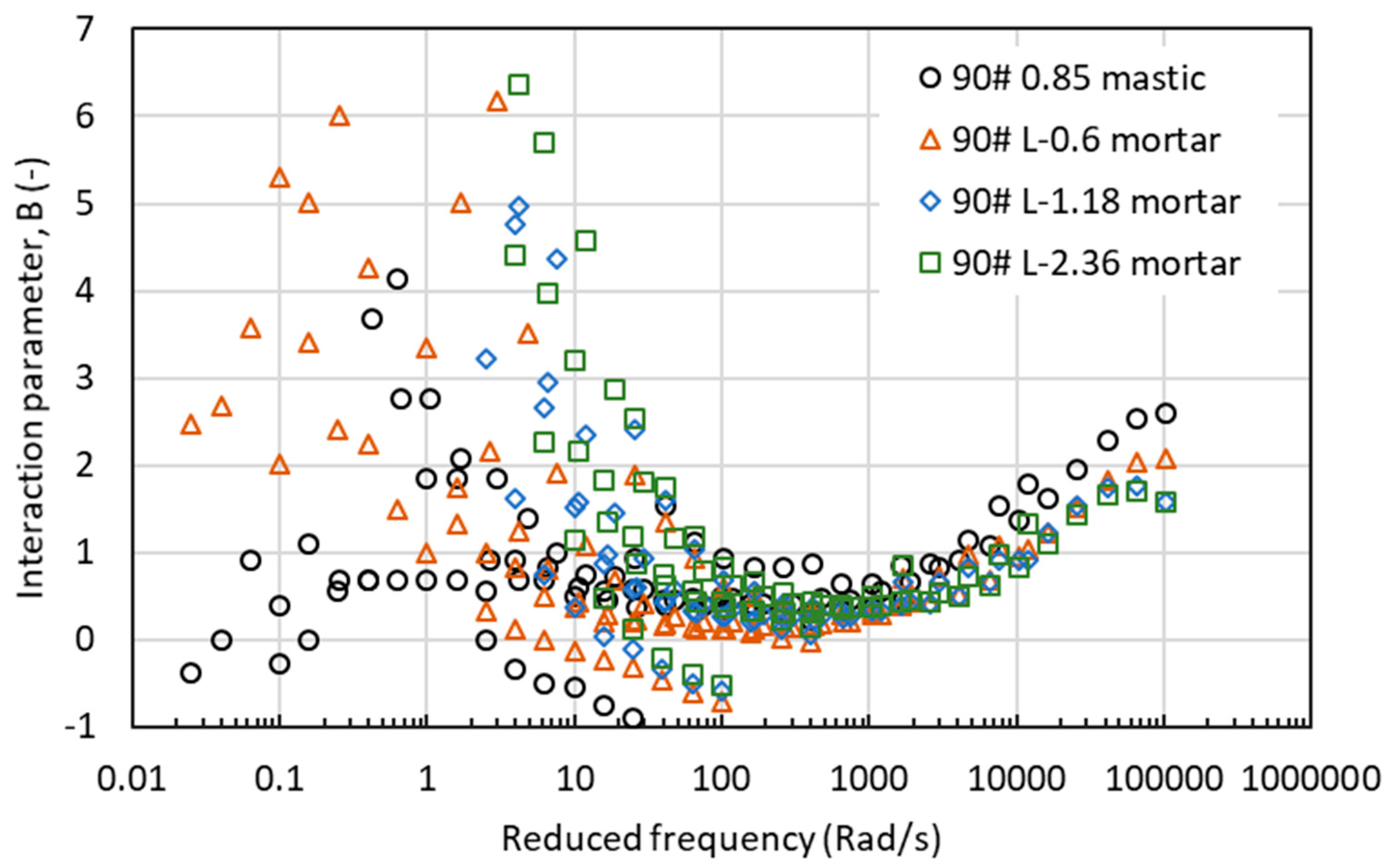
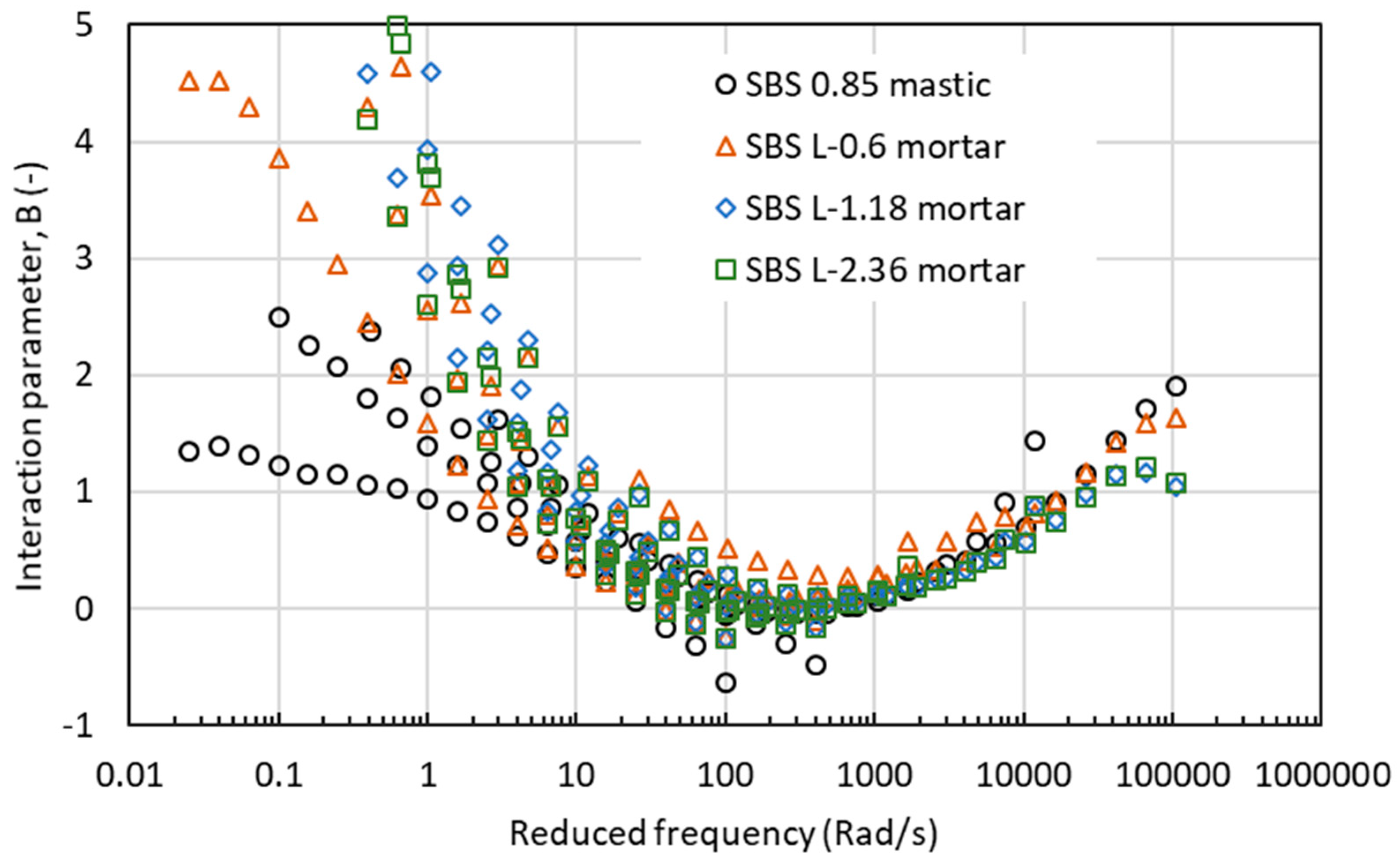
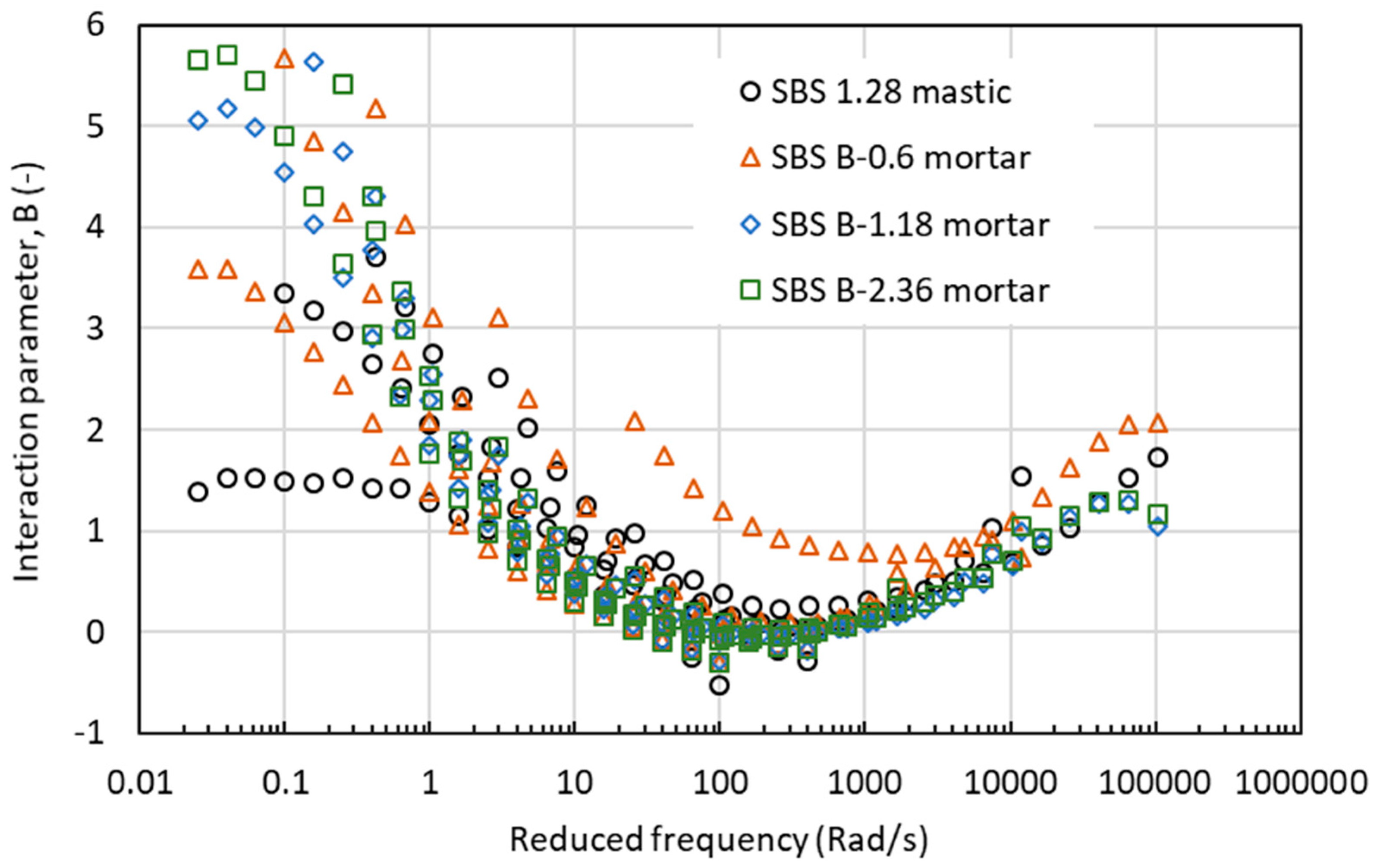
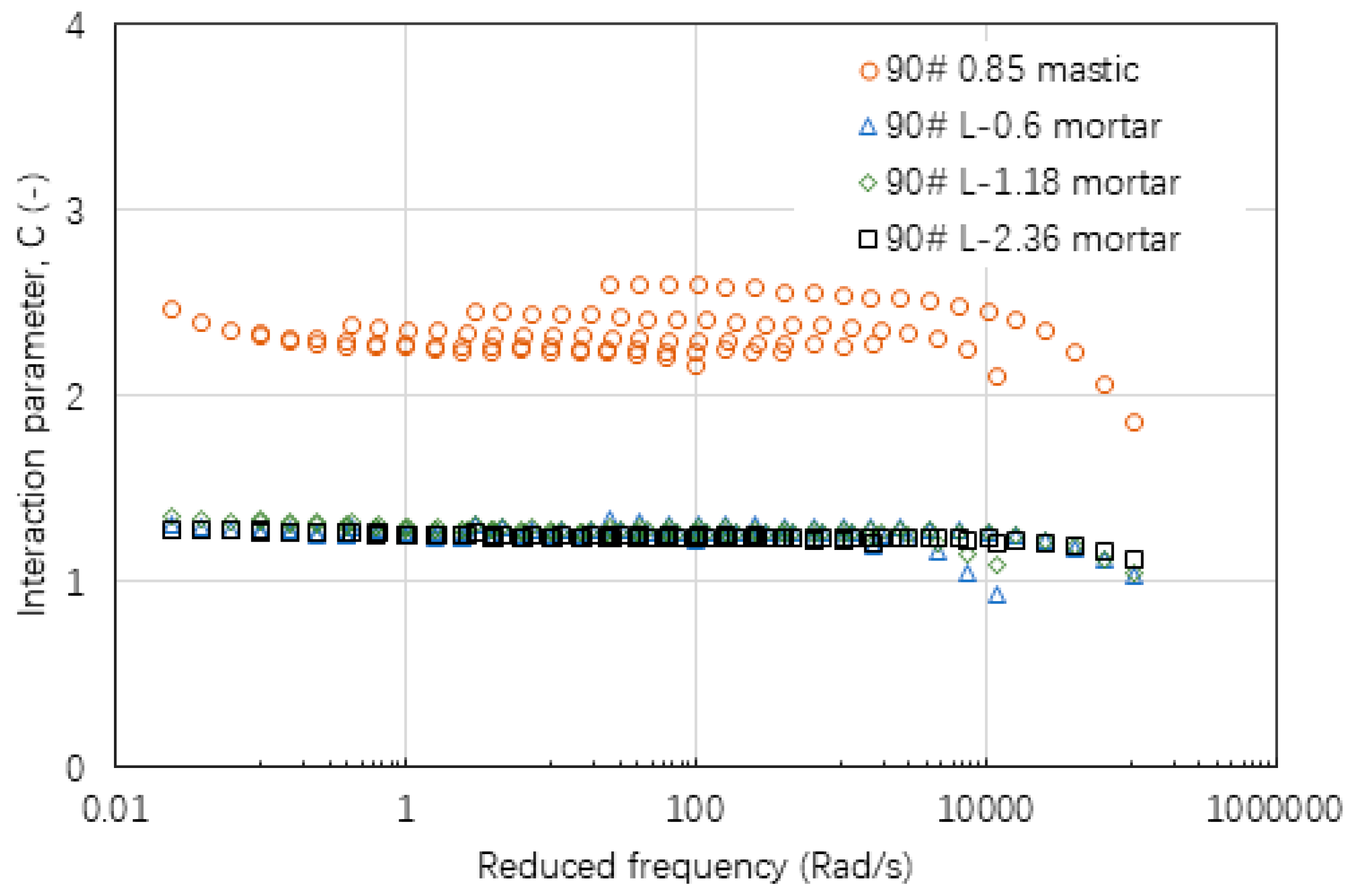
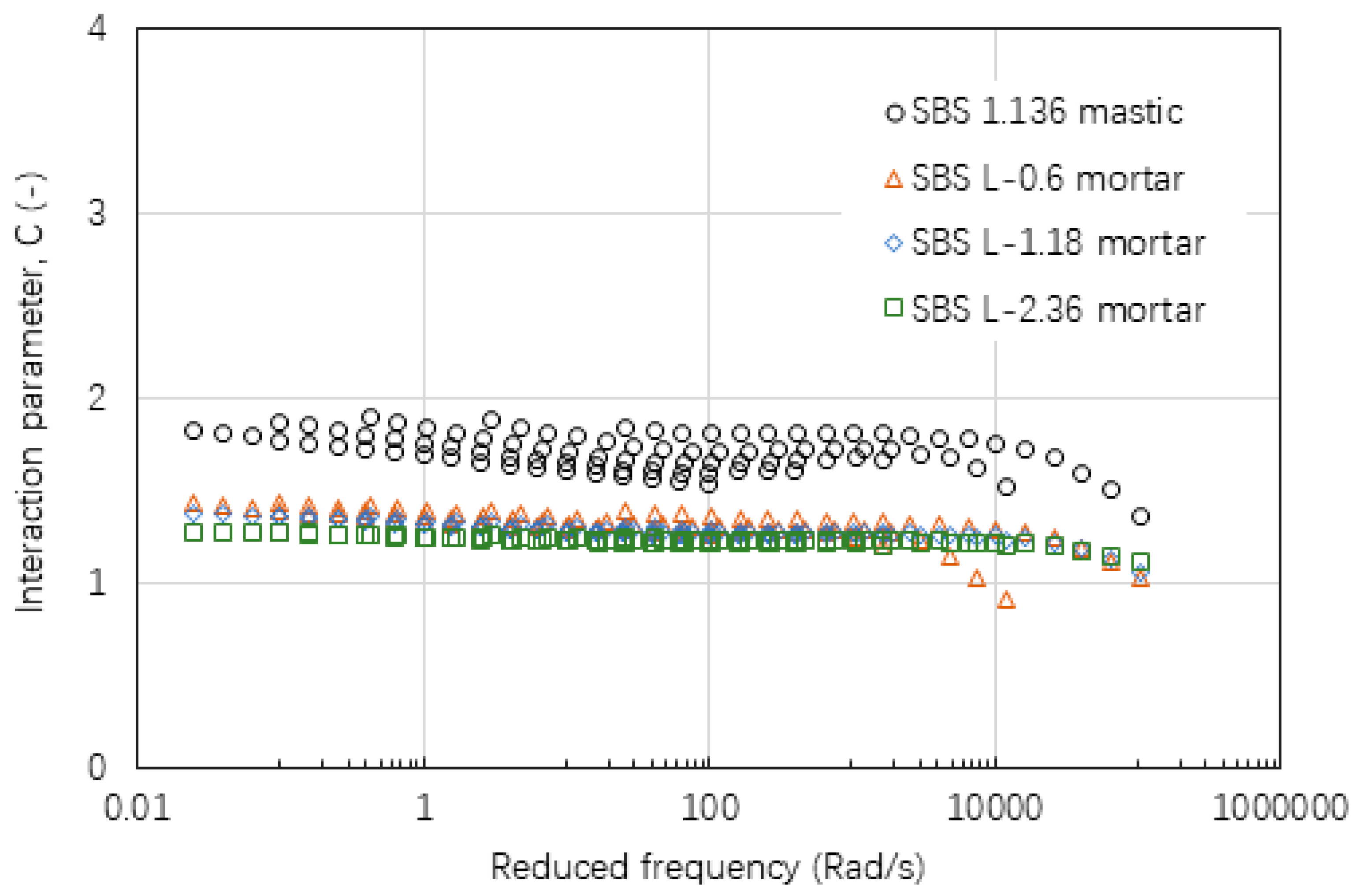
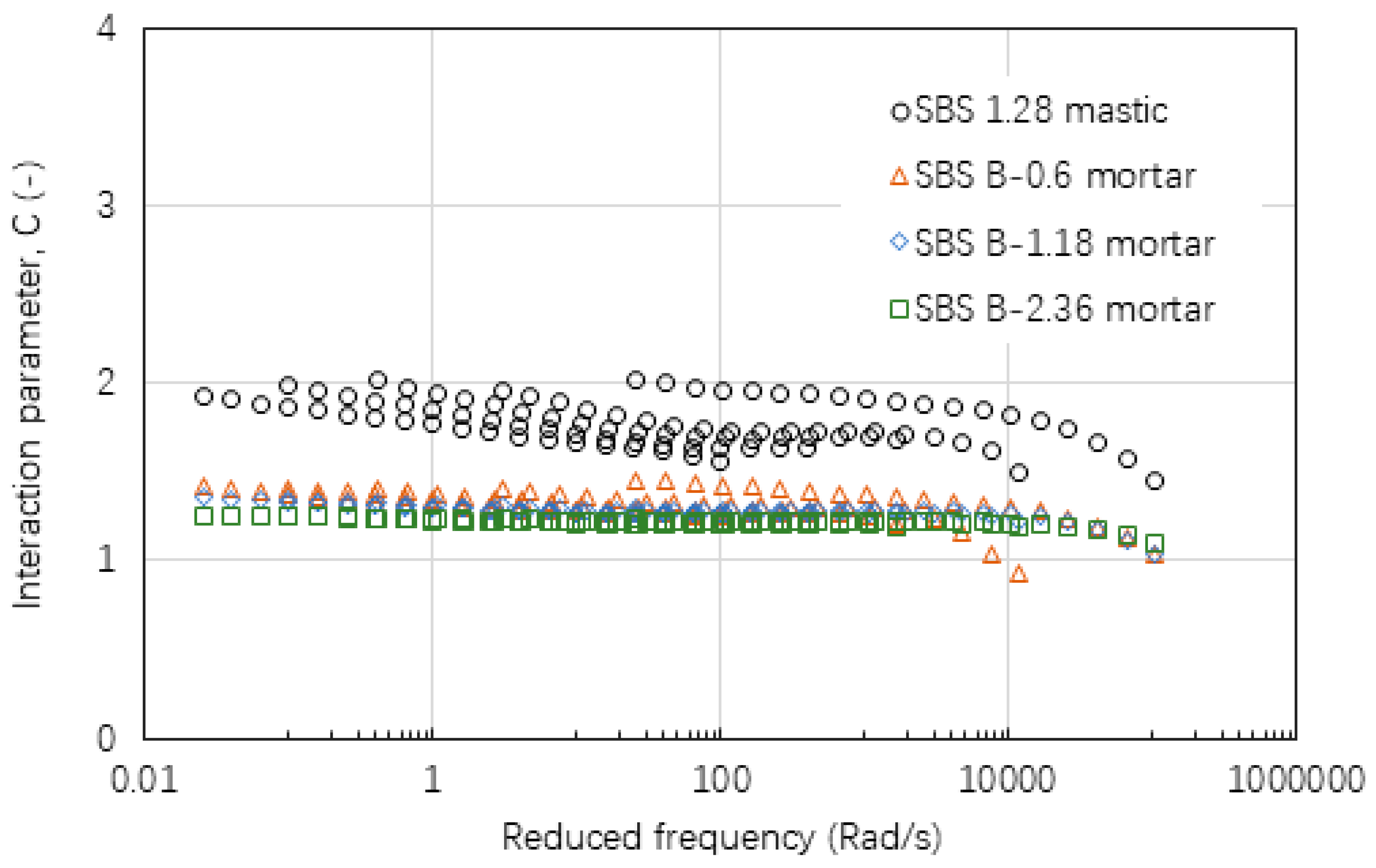
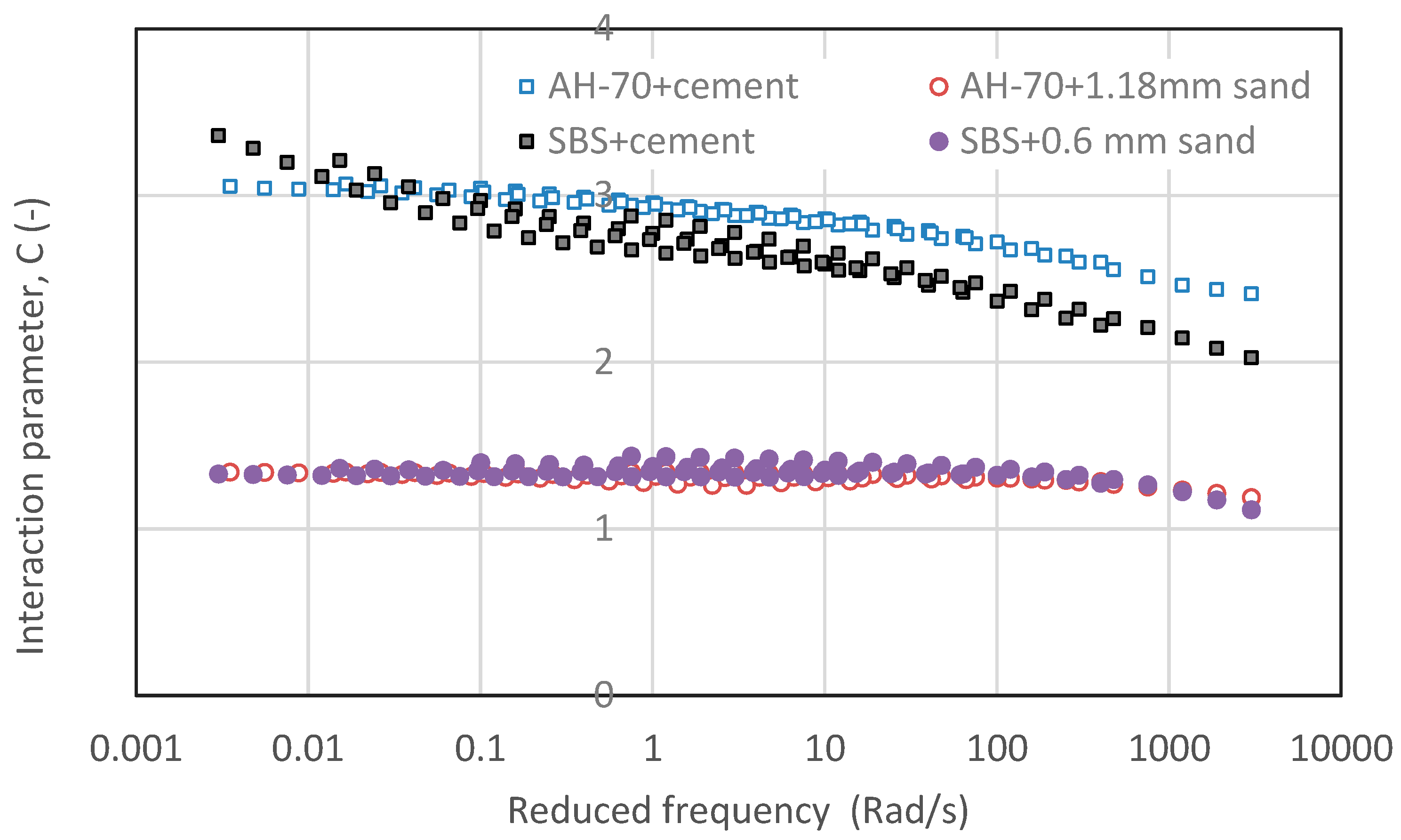
| Index | Units | Asphalt Binder | |
|---|---|---|---|
| Neat Bitumen (90#) | SBS Modified Bitumen | ||
| Penetration (25 °C, 100 g, 5 s) | 0.1 mm | 84 | 73 |
| Ductility (15 °C, 5 cm/mm) | cm | 98.1 | >100 |
| Viscosity (135 °C) | Pa·s | 0.324 | 0.645 |
| Softening point | °C | 49.5 | 52 |
| Sieve Size (mm) | Passing Percent (%) | ||
|---|---|---|---|
| AC-13 | AC-20 | AC-25 | |
| 31.5 | - | - | 100 |
| 26.5 | - | 100 | 98 |
| 19 | - | 95 | 86 |
| 16 | 100 | 83 | 79 |
| 13.2 | 95 | 72 | 69 |
| 9.5 | 77 | 61 | 47 |
| 4.75 | 53 | 41 | 34 |
| 2.36 | 37 | 30 | 24 |
| 1.18 | 27 | 23 | 18 |
| 0.6 | 19 | 16 | 13 |
| 0.3 | 14 | 11 | 10 |
| 0.15 | 10 | 9 | 8 |
| 0.075 | 6 | 5 | 5 |
| Aggregate | Basalt | Limestone | Limestone |
| Filler | Limestone | Limestone | Limestone |
| Asphalt binder | SBS | SBS | 90# |
| Asphalt binder content | 4.7 | 4.4 | 3.9 |
| Specimen | Asphalt Binder (A) | Filler Type (F) | F/A Ratio |
|---|---|---|---|
| AC-13’s mastic | SBS | Limestone powder | 1.280 |
| AC-20’s mastic | SBS | Limestone powder | 1.136 |
| AC-25’s mastic | 90# | Limestone powder | 0.850 |
| Sieve Size (mm) | Percent Composition by Weight (%) | ||||||||
|---|---|---|---|---|---|---|---|---|---|
| Basalt Aggregates | Limestone Aggregates | Limestone Aggregates | |||||||
| I | II | III | I | II | III | I | II | III | |
| 2.36 | 27.7 | - | - | 24.2 | - | - | 22.4 | - | - |
| 1.18 | 18.2 | 25.2 | - | 16.5 | 21.8 | - | 16.2 | 20.8 | - |
| 0.6 | 13.0 | 18.0 | 24.0 | 14.3 | 18.9 | 24.2 | 16.2 | 20.8 | 26.3 |
| 0.3 | 9.5 | 13.2 | 17.6 | 11.0 | 14.5 | 18.6 | 12.4 | 16.0 | 20.2 |
| 0.15 | 6.1 | 8.4 | 11.2 | 5.5 | 7.3 | 9.3 | 6.2 | 8.0 | 10.1 |
| 0.075 | 6.9 | 9.6 | 12.8 | 7.7 | 10.2 | 13.0 | 8.7 | 11.2 | 14.2 |
| Filler | 10.4 | 14.4 | 19.2 | 11.0 | 14.5 | 18.6 | 8.3 | 10.6 | 13.4 |
| Asphalt binder content | 8.1 | 11.3 | 15.1 | 9.7 | 12.8 | 16.4 | 9.7 | 12.5 | 15.8 |
| Asphalt binder | - | SBS | - | SBS | 90# | ||||
| Asphalt mixture | AC-13 | AC-20 | AC-25 | ||||||
| Type of Binder | Height (mm) |
|---|---|
| Asphalt | 1.0 |
| Mastic | 1.0 |
| Mortar with fine aggregates smaller than 0.6 mm (0.6 mortar) | 2.0 |
| Mortar with fine aggregates smaller than 1.18 mm(1.18 mortar) | 4.0 |
| Mortar with fine aggregates smaller than 2.36 mm (2.36 mortar) | 7.0 |
| Material Scale | Asphalt Binder | Filler | Fine Aggregate | Interaction Parameter, C Value |
|---|---|---|---|---|
| Mastic | 90# | Limestone (0.85:1) | - | 2.523 |
| SBS | Limestone (1.136:1) | - | 1.806 | |
| SBS | Limestone (1.28:1) | - | 1.877 | |
| Mortar | 90# | Limestone | 0.6 mm limestone | 1.281 |
| 90# | Limestone | 1.18 mm limestone | 1.272 | |
| 90# | Limestone | 2.36 mm limestone | 1.243 | |
| SBS | Limestone | 0.6 mm limestone | 1.310 | |
| SBS | Limestone | 1.18 mm limestone | 1.288 | |
| SBS | Limestone | 2.36 mm limestone | 1.233 | |
| SBS | Basalt | 0.6 mm limestone | 1.308 | |
| SBS | Basalt | 1.18 mm limestone | 1.277 | |
| SBS | Basalt | 2.36 mm limestone | 1.217 |
| Material Scale | Bitumen | Filler | Fine Aggregate | Interaction Parameter, C Value |
|---|---|---|---|---|
| Mastic | AH-70 | Cement (1:1) | - | 2.864 |
| SBS | Cement (1:1) | - | 2.678 | |
| Mortar | AH-70 | Limestone | 1.18 mm sand | 1.312 |
| SBS | Limestone | 0.6 mm sand | 1.340 |
© 2019 by the authors. Licensee MDPI, Basel, Switzerland. This article is an open access article distributed under the terms and conditions of the Creative Commons Attribution (CC BY) license (http://creativecommons.org/licenses/by/4.0/).
Share and Cite
Chen, M.; Javilla, B.; Hong, W.; Pan, C.; Riara, M.; Mo, L.; Guo, M. Rheological and Interaction Analysis of Asphalt Binder, Mastic and Mortar. Materials 2019, 12, 128. https://doi.org/10.3390/ma12010128
Chen M, Javilla B, Hong W, Pan C, Riara M, Mo L, Guo M. Rheological and Interaction Analysis of Asphalt Binder, Mastic and Mortar. Materials. 2019; 12(1):128. https://doi.org/10.3390/ma12010128
Chicago/Turabian StyleChen, Meng, Barugahare Javilla, Wei Hong, Changluan Pan, Martin Riara, Liantong Mo, and Meng Guo. 2019. "Rheological and Interaction Analysis of Asphalt Binder, Mastic and Mortar" Materials 12, no. 1: 128. https://doi.org/10.3390/ma12010128
APA StyleChen, M., Javilla, B., Hong, W., Pan, C., Riara, M., Mo, L., & Guo, M. (2019). Rheological and Interaction Analysis of Asphalt Binder, Mastic and Mortar. Materials, 12(1), 128. https://doi.org/10.3390/ma12010128





